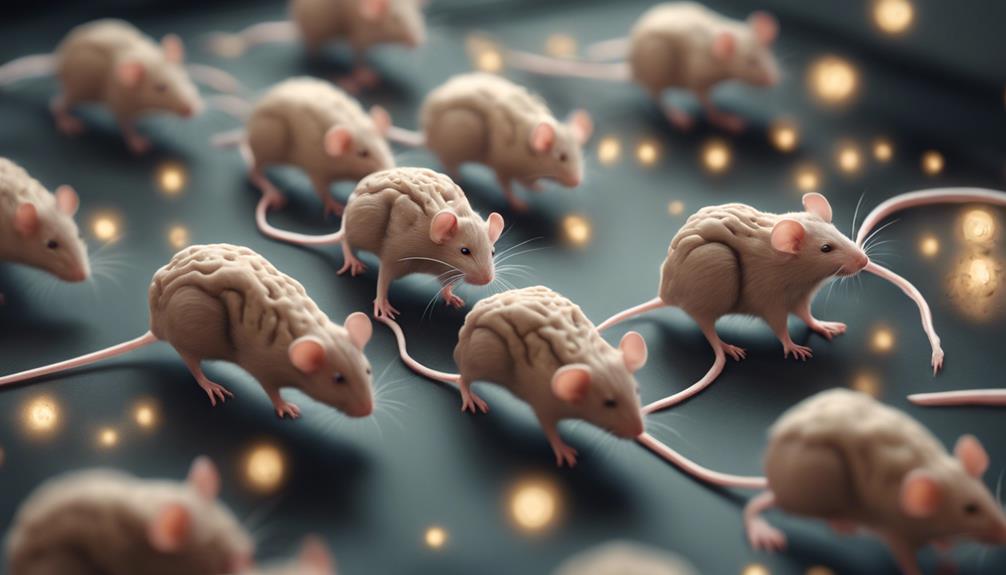Rat neural stem cells integrated into mice brains showcase significant advances in neural circuit repair and sensory restoration. This groundbreaking technique doesn't involve actual detection of cookies but emphasizes the potential benefits for sensory perception enhancement. The study demonstrates innovation in stem cell implantation and brain plasticity, highlighting the possibility of reviving olfactory senses. By utilizing rat cells in mouse brains, researchers have opened new avenues for understanding brain repair mechanisms and sensory capabilities. Further details about this fascinating research can provide deeper insights into the remarkable potential of these cross-species cell transplants.
Key Takeaways
- Rat cells integrated into mouse brains restored sensory perception.
- Improved sensory abilities in chimeric mice demonstrated success.
- Olfactory neural circuit repair enhanced mice's sense of smell.
- Stem cell transplants improved cognitive functions in animals.
- Rat cell integration showcased potential for brain plasticity.
Stem Cell Implantation in Mice Brains
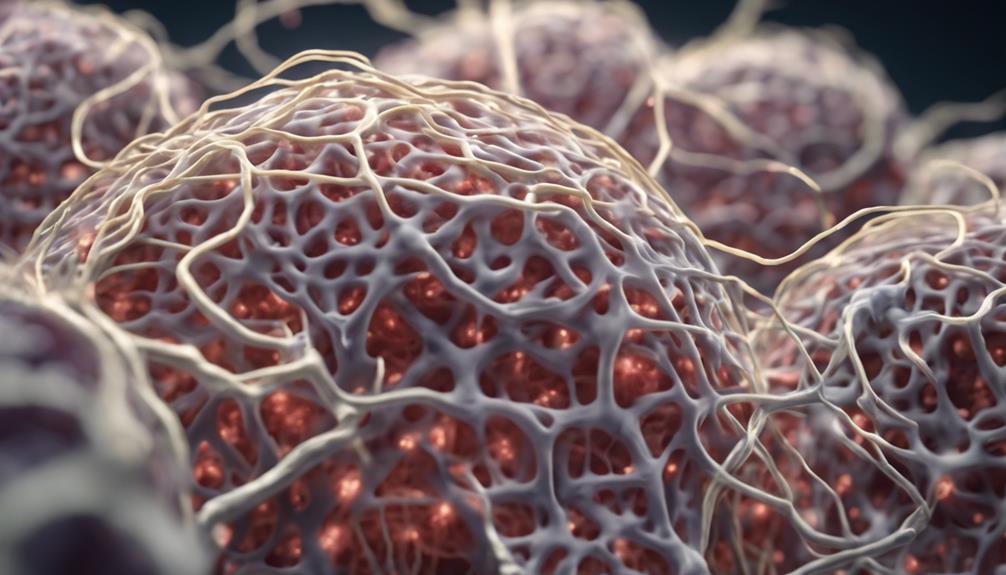
Using a groundbreaking technique, researchers implanted rat stem cells into mouse brains to restore olfactory neural circuits. This innovative approach aimed to investigate the potential of stem cell transplants in enhancing sensory perception.
By integrating rat cells into the mouse brain, the study successfully demonstrated that the implanted cells enabled mice to regain their sense of smell. These chimeric mice, with a mixture of rat and mouse neurons, displayed an improved ability to locate hidden cookies in experimental settings.
The presence of rat cells within the mouse brain not only restored olfactory function but also showcased the adaptability and integration of foreign cells within a different species. This process of stem cell implantation opens new possibilities for understanding neural circuitry and sensory restoration, highlighting the remarkable capacity of stem cells to influence and enhance neurological functions across species boundaries.
Restoring Olfactory Neural Circuits

Rat neural stem cells have demonstrated the capacity to restore olfactory neural circuits in mice that lack functional smell neurons. This procedure resulted in the restoration of the sense of smell in a subgroup of the mice involved in the experiment.
The integration of rat cells into the brains of mice without olfactory neurons could potentially pave the way for advancements in neural circuit repair and sensory restoration.
Neural Circuit Repair
Restoring olfactory neural circuits through stem cell transplants demonstrates promising advancements in neural circuit repair for sensory functions. In a groundbreaking study, researchers successfully integrated rat neural stem cells into the brains of mice lacking olfactory neurons. This innovative approach resulted in the creation of functional neural circuits dedicated to olfactory perception within the brains of hybrid mice.
The chimeric mice, now equipped with rat cells, displayed enhanced sensory abilities, particularly in detecting hidden cookies, showcasing the efficacy of interspecies cell integration in restoring sensory functions.
The experiment not only highlighted the potential of stem cell transplants in repairing neural circuits but also emphasized the remarkable adaptability and flexibility of brain structures. By incorporating stem cells from rats into the brains of mice, scientists were able to demonstrate the capacity for neural circuit repair and regeneration, offering new possibilities for treating sensory impairments and advancing our understanding of brain plasticity.
Olfactory Sensory Restoration
Integrating rat neural stem cells into the brains of mice lacking olfactory neurons led to the restoration of sensory perception. The successful restoration of olfactory sensory function in mice was achieved through the incorporation of rat cells into the mouse brains.
The competition between the rat and mouse cells played a vital role in influencing the effectiveness of restoring the olfactory neural circuits. Remarkably, the rat stem cells were able to form independent processing centers within the brains of mice that didn't possess native olfactory neurons.
This breakthrough suggests that stem cell transplants have the potential to enhance sensory capacities in animals. By restoring olfactory neural circuits in mice, researchers have disclosed the possibility of customizable circuit replacements for the study of various neurological diseases.
These findings open new avenues for exploring the restoration of sensory functions through innovative cellular interventions, paving the way for future advancements in the field of olfactory sensory restoration.
Brain Cell Integration
The successful incorporation of rat neural stem cells into the brains of mice lacking olfactory neurons led to the restoration of sensory perception, showcasing potential advancements in brain cell integration for olfactory neural circuit repair. This breakthrough in stem cell integration offers promising insights into enhancing the sense of smell through innovative approaches.
The restoration of olfactory neural circuits in mice lacking smell neurons highlights the remarkable adaptability of the brain and its capacity for regeneration through stem cell interventions. The competition between mouse and rat cells influencing the success of integrating rat cells underscores the complexity of neural regeneration processes.
The formation of independent processing centers by rat stem cells in mice without olfactory neurons demonstrates the intricate interplay between different cell types in neural circuitry repair. This research not only holds implications for restoring sensory functions but also sheds light on the brain's plasticity in accommodating diverse cellular characteristics, paving the way for future advancements in neural regeneration and sensory enhancement.
Regaining Sense of Smell in Mice
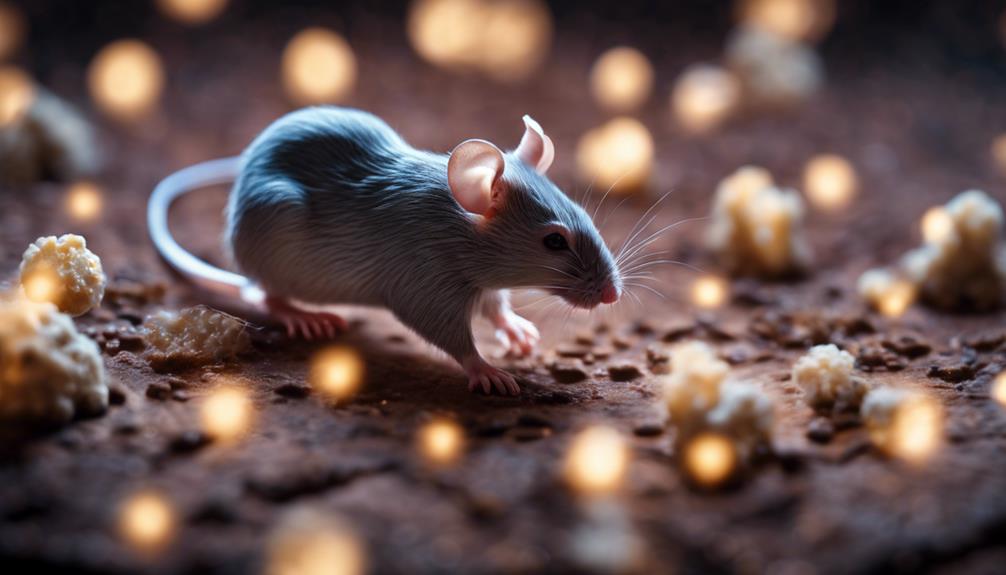
Researchers successfully revived the sense of smell in mice by using rat stem cells. In a groundbreaking study, scientists introduced rat cells into mice lacking olfactory neurons, leading to the restoration of their ability to smell.
These chimeric mice with rat cells exhibited remarkable behavior, easily detecting hidden cookies in experiments. The rat cells proved to be functional within the mouse brains, forming neural pathways essential for sensing smells. The interaction between rat and mouse cells played a pivotal role in the success of this sensory perception experiment.
This study marks a significant milestone as it demonstrates the first instance of an animal utilizing sensory hardware from another species to perceive the world. By leveraging the unique capabilities of rat stem cells, researchers have opened up new possibilities for understanding and potentially treating sensory disorders in mice and potentially other species.
Innovative Pluripotent Stem Cell Use

Utilizing pluripotent stem cells in a groundbreaking manner, scientists achieved the restoration of olfactory neural circuits in mice through the introduction of rat neural stem cells. This innovative use of pluripotent stem cells showcases the potential for customizable circuit replacements in neurological studies.
The experiment's success in integrating rat cells into mice brains without olfactory neurons highlights the flexibility of brain plasticity with interspecies cell transplants. The competition observed between rat and mouse cells in the brain could have influenced the outcomes on sensory perception, emphasizing the intricate nature of such interventions.
Timing for Precise Cell Transplant

Timing plays a pivotal role in the successful integration of rat cells into mouse embryos for precise cell transplants. Researchers at the University of Minnesota, led by Jun Wu and Kristin Baldwin, have shown that injecting rat stem cells into mouse embryos at early developmental stages is essential for ensuring synchronization of cell growth.
This precise timing allows the rat cells to adopt traits of mouse cells once integrated into the brain environment, aiding in the restoration of the sense of smell. The chimeric mice, with a combination of rat neurons, successfully demonstrated their ability to sniff out hidden cookies, showcasing functional integration.
Understanding the key timing for cell transplants is essential for future research on organ development and brain repair. By pinpointing the ideal window for introducing rat cells into mouse embryos, researchers can enhance the chances of successful integration and functional outcomes, paving the way for advancements in regenerative medicine and neuroscience.
Forming Independent Processing Centers
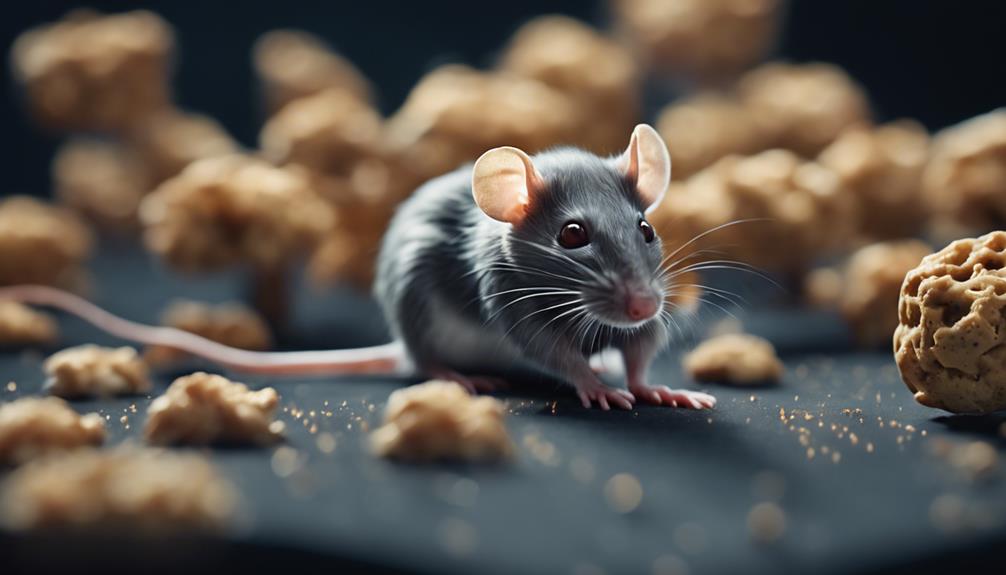
Rat stem cells forming independent processing centers within mice brains can lead to intriguing implications. These centers could potentially localize brain activity in new ways, enhancing sensory perception beyond previous limits.
The functional integration of rat neurons into mouse brains showcases the complex yet fascinating possibilities of stem cell transplants in expanding sensory capacities.
Brain Activity Localization
Forming independent processing centers in the brain plays an important role in localizing brain activity. These processing centers, formed by rat stem cells in mice brains lacking smell neurons, are essential for integrating sensory information and restoring functions like smell.
The competition between rat and mouse cells in developing structures for olfactory processing demonstrates the plasticity of neural circuits. This successful integration of rat cells into the existing neural networks of mice suggests a remarkable adaptability of the brain in accommodating new components.
The experiment not only highlights the potential for enhancing sensory capabilities through stem cell transplants but also sheds light on the intricate mechanisms of neural plasticity and the formation of specialized processing centers within the brain.
- The integration of rat cells in mice brains emphasizes the dynamic nature of neural circuits.
- Stem cell transplants hold promise for expanding sensory capabilities in interspecies chimeras.
- The competition between rat and mouse cells showcases the adaptability of the brain.
- Forming independent processing centers is essential for efficient brain activity localization.
Enhanced Sensory Perception
In the intricate neural networks of mice brains, the pivotal integration of rat cells has led to the formation of independent processing centers, demonstrating remarkable adaptability in enhancing sensory perception. This groundbreaking experiment showcased the potential of interspecies cell transplants, particularly with rat cells integrated into mouse brains.
By introducing rat cells into the mouse neural environment, researchers were able to restore the sense of smell in mice that lacked olfactory neurons. The competition observed between rat and mouse cells played a significant role in the success of this innovative approach, highlighting the intricate dynamics at play within neural networks.
Stem cell transplants from rats into mice not only expanded sensory capacities in animals but also paved the way for chimeric mice with rat neurons to easily locate hidden cookies, a clear indication of the enhanced sensory perception achieved through this method. The seamless integration of rat stem cells into mouse brains exemplifies the potential to restore and enhance sensory functions through interspecies cell transplants, opening up new possibilities for sensory research and neural regeneration.
Functional Neural Integration
The integration of rat cells into mice brains led to the development of distinct processing centers for sensory perception. This functional neural integration allowed chimeric mice to have specialized pathways for detecting smells, showcasing the potential of rat neurons to enhance sensory capabilities in mice.
The successful restoration of the sense of smell in mice lacking olfactory neurons through rat stem cell transplants highlights the promising applications of this research in regenerative medicine. The competition between rat and mouse cells might've influenced the establishment of these independent processing centers, indicating the importance of cell interactions in neural integration processes.
- Rat neurons injected into mice brains formed specialized processing centers for sensory perception.
- Chimeric mice with rat neurons developed functional neural pathways for smell detection.
- Rat stem cells successfully restored the sense of smell in mice lacking olfactory neurons.
- Competition between rat and mouse cells played a role in shaping the success of sensory integration.
Expanding Sensory Capacities in Animals

By enhancing sensory capacities in animals through stem cell transplants, researchers have successfully restored the sense of smell in mice using rat cells. The experiments showed that rat cells could effectively replace olfactory neurons in mice, allowing them to regain their ability to detect scents.
The significance of the competition between rat and mouse cells played a pivotal role in the success of these sensory restoration procedures. Surprisingly, the rat stem cells formed independent processing centers within the mice brains, highlighting the potential for cross-species cell integration to expand sensory capabilities in animals.
These findings open up new possibilities for enhancing sensory functions in various species through innovative techniques like stem cell therapy. The study not only demonstrated the feasibility of restoring lost senses but also suggested a pathway towards developing advanced sensory capacities beyond natural capabilities.
Customizable Circuit Replacements
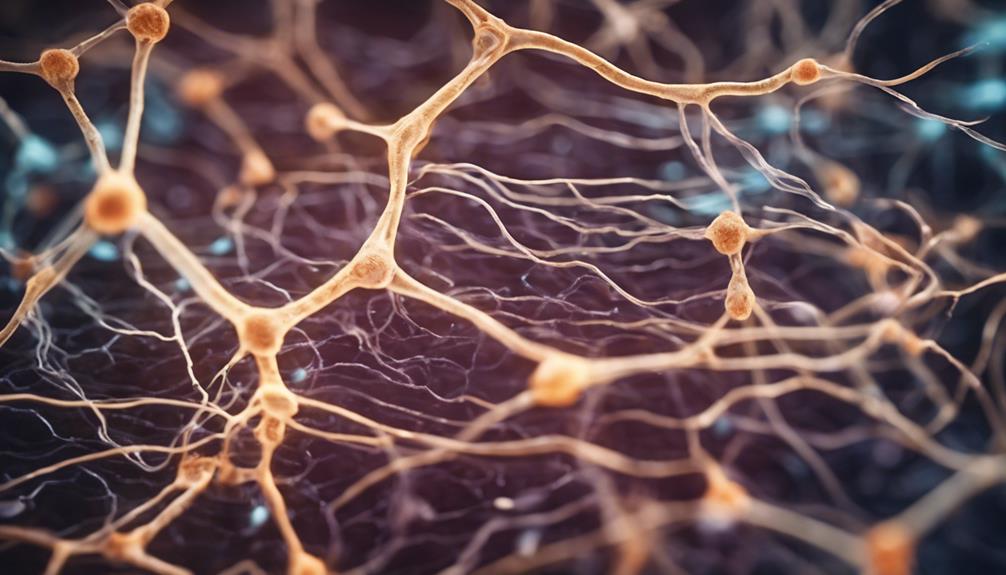
The study's findings on rat cells growing in mice brains for cookie detection highlight the potential for customizable circuit replacements in neurological research.
This breakthrough showcases the possibility of enhancing sensory capacities through targeted neural activity, ultimately leading to improved cognitive functions.
Understanding how different species' characteristics can be integrated into brain circuitry offers promising avenues for developing innovative treatments for neurological diseases.
Enhanced Sensory Capabilities
Stem cell transplants have shown promising results in enhancing sensory capabilities by forming customizable circuit replacements in the brains of mice. This innovative approach taps into the potential of stem cells to contribute to sensory restoration and exploit brain plasticity for improved functions.
To engage the audience effectively, consider these four key points:
- Stem Cell Potential: Stem cells possess the ability to differentiate into various cell types, making them ideal candidates for sensory restoration applications.
- Enhanced Sensory Functions: By forming customizable circuit replacements, stem cell transplants can enhance sensory capabilities, as seen in the successful restoration of the sense of smell in mice lacking olfactory neurons.
- Brain Plasticity: Research is shedding light on the brain's plasticity, demonstrating its capacity to accommodate characteristics from different species to enhance sensory functions.
- Future Implications: The study's findings pave the way for developing personalized circuit replacements using stem cell transplants, offering hope for treating neurological diseases and improving sensory experiences.
Targeted Neural Activity
In the quest for enhanced sensory capabilities, researchers are exploring customizable circuit replacements through targeted neural activity. The recent success in restoring the sense of smell in mice by introducing rat cells highlights the potential of using stem cells to create specialized neural circuits.
This approach not only addresses sensory deficiencies but also sheds light on brain plasticity, the brain's ability to adapt and reorganize itself. By incorporating rat stem cells into mice brains lacking olfactory neurons, scientists were able to observe the formation of independent processing centers. This phenomenon showcases how neural activity can be targeted and manipulated to enhance sensory functions.
Understanding how different species' characteristics can be integrated into new neural circuits provides valuable insights into neurological diseases and potential therapeutic interventions. The competition between mouse and rat cells influencing the experiment's outcome underscores the intricate nature of neural interactions and the importance of precise manipulation for successful customizable circuit replacements.
Improved Cognitive Functions
Integrating rat cells into mice brains has shown promising advancements in enhancing cognitive functions through customizable circuit replacements. This innovative approach not only enabled mice to improve their sense of smell and successfully detect hidden cookies but also opened up possibilities for enhancing other cognitive abilities. The hybrid brain models created by integrating rat cells into mice brains have the potential to revolutionize our understanding of brain plasticity and neurological diseases. Here are four key points to ponder:
- Enhanced Cognitive Functions: The integration of rat cells in mice brains has demonstrated the ability to boost cognitive functions beyond just sensory enhancements.
- Flexibility of Brain Plasticity: Stem cell transplants from different species can expand sensory capacities, showcasing the remarkable adaptability of the brain.
- Ethical Research: Cross-species brain models offer a way to study neurological diseases without ethical concerns, providing valuable insights into brain function.
- Cost-Effective Testing: Hybrid brain models present a cost-effective alternative for testing potential treatments and drug therapies, making research more accessible and efficient.
Potential of Stem Cell Transplants

Demonstrating remarkable potential, rat stem cell transplants successfully restored the sense of smell in mice lacking olfactory neurons. By integrating rat cells into mouse brains, functional neural pathways were created, enhancing sensory perception. This breakthrough highlights the promising capabilities of stem cell transplants in repairing and improving sensory functions within neural circuits. The success of this experiment was influenced by the competition between rat and mouse cells, showcasing the intricate dynamics involved in such procedures.
Stem cell transplants offer exciting implications for the development of customizable circuit replacements, particularly in the study of neurological diseases. This innovative approach holds the key to understanding and potentially treating conditions that affect sensory perception. The ability to manipulate neural pathways through stem cell transplants opens up new avenues for research and therapeutic interventions. As science continues to unravel the mysteries of the brain, the potential of stem cell transplants in enhancing sensory functions remains a compelling area of exploration.
Rat Neurons Repairing Mouse Brains
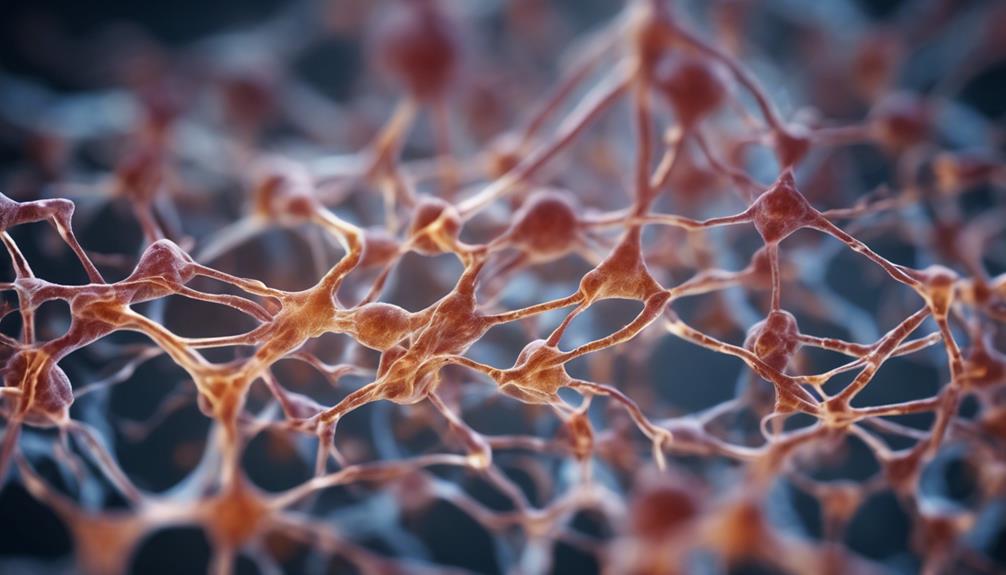
Successfully repairing missing brain circuitry, rat neurons integrated into mouse brains showcased remarkable cross-species neural repair capabilities. Chimeric mice with rat cells not only regained the ability to sense smell but also demonstrated an enhanced capacity to locate hidden cookies, emphasizing the effectiveness of this neural repair mechanism.
The injection of rat stem cells into mouse embryos played a pivotal role in restoring olfactory neural pathways in mice, highlighting the potential for therapeutic applications in neurological disorders. The integration of rat cells in mouse brains not only resulted in successful cross-species neural repair but also paved the way for further exploration into the regenerative properties of different species' neural cells.
The research published in the journal Cell underscored the significance of utilizing rat neurons for repairing mouse brains, opening new avenues for understanding neural repair mechanisms across species boundaries.
Sensory Capacity Enhancement in Mice

The sensory capacity of mice was greatly enhanced through the integration of rat stem cells that enabled chimeric mice to detect hidden cookies with precision. By incorporating rat cells into mouse brains, researchers observed a remarkable improvement in sensory perception, particularly in the olfactory domain.
This integration of rat neurons alongside mouse cells resulted in the development of functional neural pathways dedicated to sensing smells. Through the strategic manipulation of specific neurons responsible for smell in mice, scientists were able to investigate and enhance sensory perception in chimeric mice.
The chimeras exhibited a heightened ability to locate food compared to their non-chimeric counterparts with similar genetic modifications. This groundbreaking experiment not only showcased the adaptability of sensory hardware across species boundaries but also highlighted the potential for enhancing sensory capabilities through such innovative approaches.
Rat Cells Aiding in Smelling Cookies
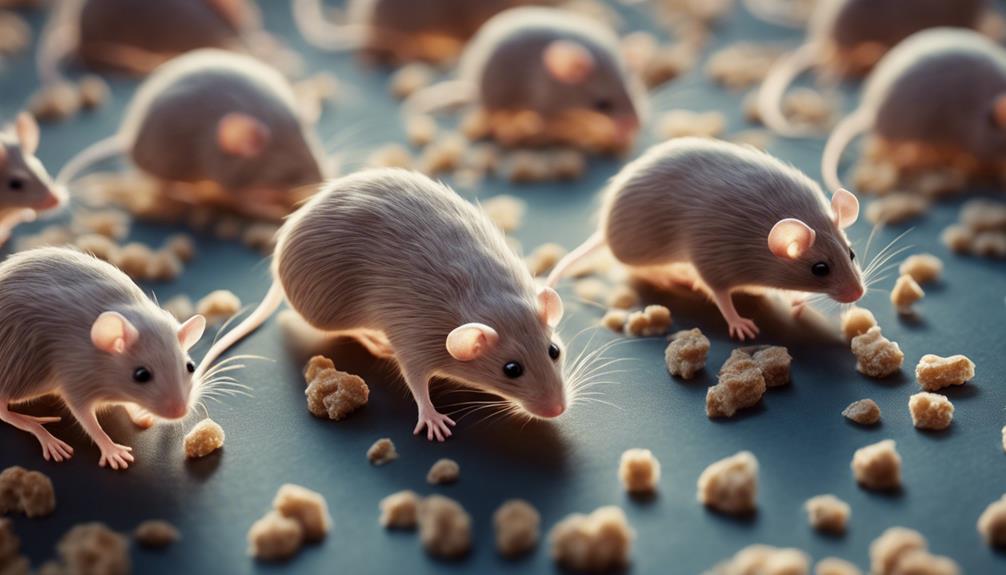
Rat cells injected into mouse brains played a pivotal role in enhancing the mice's ability to smell and detect scents.
By forming functional neural pathways, these rat cells integrated seamlessly into the mouse brains, effectively boosting their olfactory capabilities.
This groundbreaking experiment showcased the potential for interspecies chimerism to revolutionize sensory perception and neural function in mice.
Rat Cells Detect Scents
Using rat cells in their brains, the chimeric mice efficiently detected the scent of hidden cookies. This innovative approach involved injecting rat stem cells into mouse embryos, resulting in chimeric mice with enhanced olfactory capabilities.
Here are four key points regarding the use of rat cells in mouse brains for detecting scents:
- Enhanced Sensory Perception: Rat cells integrated into the mice brains allowed them to perceive scents more effectively, leading to successful detection of hidden cookies.
- Improved Olfactory Capabilities: Research demonstrated that the presence of rat neurons in the mice brains notably enhanced their ability to detect and locate scents in their environment.
- Interspecies Chimerism: The study highlighted the potential of interspecies chimerism in enhancing sensory functions, showcasing the benefits of cross-species cell integration for specific tasks.
- Practical Applications: This advancement opens doors to potential applications in various fields where heightened sensory perception is advantageous, such as search and rescue operations or medical diagnostics.
Integration in Mouse Brains
Integration of rat cells in mouse brains greatly enhanced their ability to detect scents, exemplified by the successful location of hidden cookies. The chimeric mice, with the addition of rat neurons, displayed a remarkable improvement in sensory perception.
Rat cells formed distinct processing centers within the mouse brains, establishing functional neural pathways that aided in the identification of scents, particularly the delicious aroma of cookies. The study published in the journal Cell underlined the efficacy of utilizing rat cells to boost sensory capabilities in mice, showcasing the potential for cross-species neural integration in enhancing olfactory functions.
This groundbreaking research sheds light on the intricate mechanisms of neural circuitry and how introducing rat cells into mouse brains can significantly impact sensory perception. The successful detection of hidden cookies by the chimeric mice underscores the positive outcomes of this integration, emphasizing the role of rat cells in augmenting sensory abilities in the animal model.
Enhancing Olfactory Capabilities
The addition of rat cells to mouse brains greatly enhanced their ability to detect scents, as evidenced by their successful identification of hidden cookies. This innovative approach involved injecting rat stem cells into mouse embryos lacking smell neurons, which effectively restored the sense of smell in the chimeric mice. By creating chimeras with rat cells integrated into their brains, researchers enabled these mice to easily sniff out mini Oreo cookies in experiments, showcasing their improved olfactory capabilities.
Key Points:
- Rat stem cells injected into mouse embryos lacking smell neurons successfully restored the sense of smell in mice.
- Chimeric mice with rat cells could easily sniff out hidden mini Oreo cookies in experiments.
- The integration of rat neurons into mouse brains enabled the chimeric mice to perceive the world using sensory hardware from another species.
- Researchers genetically manipulated mice to deactivate smell neurons and then injected rat stem cells to restore the mice's smelling abilities.
Study on Stem Cell Transplants
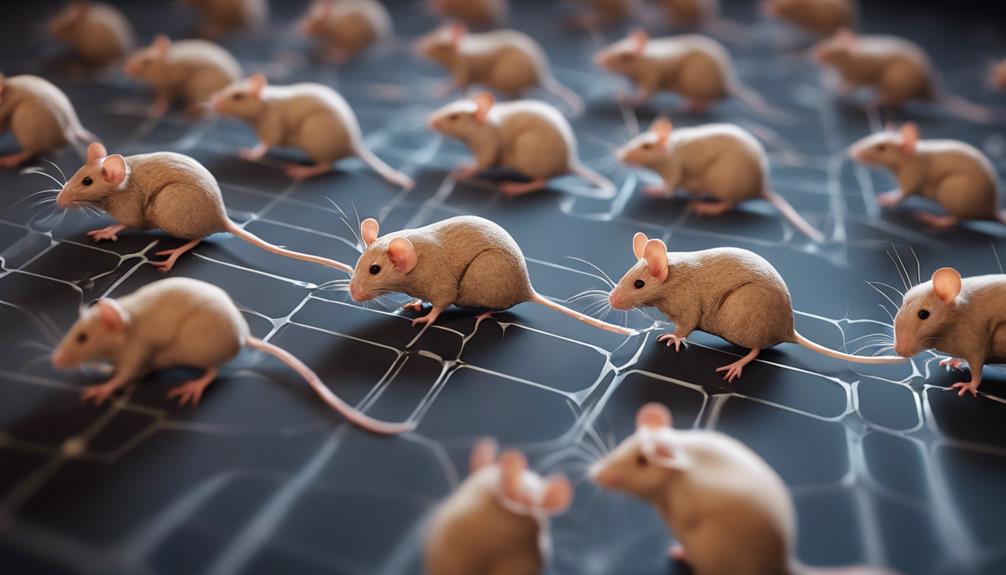
In a groundbreaking study on stem cell transplants, rat stem cells were successfully integrated into mouse embryos lacking smell neurons to restore olfactory neural circuits. The chimeric mice, now equipped with rat cells in their brains, regained their sense of smell, showcasing the potential of stem cell transplants to enhance sensory capabilities in animals. These rat cells formed independent processing centers within the mouse brains, aiding in their food-seeking behavior, particularly in detecting cookies. This research not only highlights the remarkable adaptability of stem cells but also opens avenues for developing customizable circuit replacements for studying neurological diseases. The successful integration of rat cells into mouse brains paves the way for further exploration into the mechanisms underlying sensory processing and could potentially lead to innovative treatments for neurological conditions. The table below provides a summary of the key findings from this study on stem cell transplants:
| Key Findings |
|---|
| Rat stem cells integrated into mice |
| Chimeric mice regained sense of smell |
| Potential for enhancing sensory capabilities |
Insights Into Neurological Research
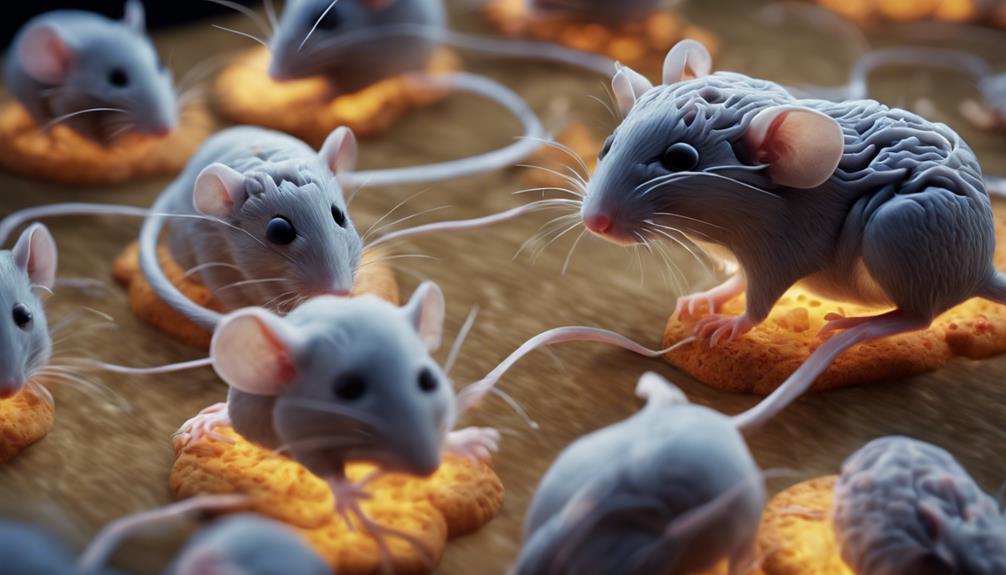
Rat cells injected into mouse brains for cookie detection revealed novel insights into neurological research, shedding light on interspecies chimerism and sensory functions. This groundbreaking study conducted at the University of Texas Southwestern showcased the remarkable potential of hybrid brains in understanding brain plasticity and sensory perception. By integrating rat cells into mouse brains, researchers observed the restoration of the sense of smell in mice lacking olfactory neurons, underscoring the promise of cell replacement therapies in treating neurological disorders. The chimeric mice with rat cells not only regained their olfactory abilities but also excelled in locating hidden cookies, emphasizing the improved sensory capabilities resulting from interspecies cellular integration. These findings offer valuable insights into the mechanisms underlying brain development and repair, opening new avenues for further exploration into cross-species effects on sensory functions and potential therapeutic applications.
- The study conducted at the University of Texas Southwestern demonstrated the successful integration of rat cells into mouse brains for sensory restoration.
- Chimeric mice showcased enhanced sensory perception and the ability to locate hidden cookies.
- Insights from this research highlight the potential of cell replacement therapies in addressing neurological disorders.
- Understanding interspecies chimerism provides valuable knowledge for advancing neurological research and brain repair mechanisms.
Creating Customizable Circuit Replacements
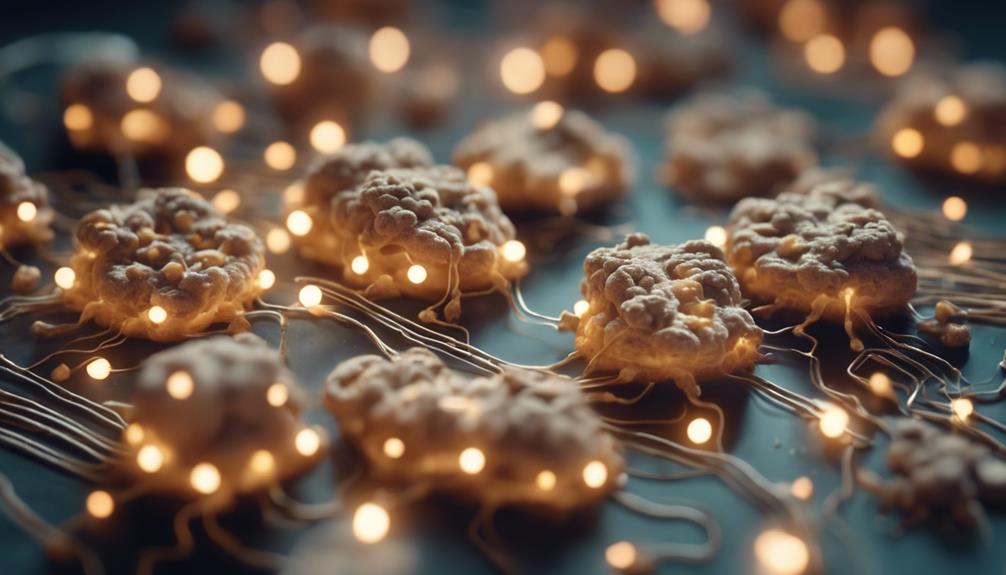
Using advanced stem cell technology, researchers have tapped into the potential for customizable circuit replacements in neurological studies. By successfully incorporating rat stem cells into mice brains to restore the sense of smell, the study sheds light on the intriguing possibilities of altering sensory perception through innovative techniques.
The competition observed between rat and mouse cells in influencing the success of the sensory perception experiment underscores the complexity and adaptability of such customizable circuit replacements. Importantly, the formation of independent processing centers by rat stem cells in mice lacking olfactory neurons opens new avenues for understanding brain cell interactions and their impact on sensory functions.
These findings not only highlight the promising applications of stem cells in neurological research but also suggest a future where customized circuit replacements could enhance sensory capacities in animals, paving the way for potential breakthroughs in neuroscience and beyond.
Frequently Asked Questions
Are Rats With Human Brain Cells Still Just Rats?
When pondering whether rats with human brain cells remain solely rats, it's important to acknowledge that the presence of human brain cells in rats blurs traditional species boundaries.
While the core genetic makeup defines an organism's species, the integration of human brain cells complicates this classification.
The chimeric nature challenges simplistic categorizations, raising profound ethical and philosophical questions about identity, consciousness, and the essence of being.
What Was the Rat Experiment in the 1960s?
In the 1960s, researchers conducted an experiment injecting rat cells into mouse brains. The rat cells integrated into the mouse brains, restoring the sense of smell in mice lacking specific neurons.
This experiment demonstrated that rat cells could influence sensory perception in mice, helping them detect hidden cookies. Such interspecies cell integration showcased the potential for restoring missing brain functions.
The success of this rat-mouse hybrid experiment set the stage for further studies on brain development and repair mechanisms.
What Is the Most Famous Rat Experiment?
The most famous rat experiment involves the injection of rat cells into mice brains to restore their sense of smell. This groundbreaking research successfully enabled the mice to sniff out hidden cookies.
The study, published in the journal Cell, highlighted the potential of interspecies cell integration in enhancing sensory perception. The experiment demonstrated the unique ability of rat cells to promote food-seeking behavior in mice lacking the sense of smell.
Why Are Rats Used for Brain Research?
Rats are preferred in brain research due to their complex neural structures and similarities to humans in brain functions.
Their well-developed olfactory systems make them ideal for studying sensory perception and smell-related research.
Rat neurons can be integrated into mouse brains to study brain plasticity, repair mechanisms, and interspecies interactions.
Using rat cells in mice brains aids in understanding neural circuitry, behavior, and potential therapies for brain-related conditions.
Conclusion
To sum up, the innovative use of pluripotent stem cells in mice brains has shown promising results in restoring olfactory neural circuits and regaining their sense of smell. This study offers valuable insights into neurological research and the potential for creating customizable circuit replacements.
The collaboration between rat and mice cells to aid in smelling cookies is a groundbreaking achievement, demonstrating the remarkable capabilities of stem cell transplants. This research opens up exciting possibilities for future advancements in the field.
